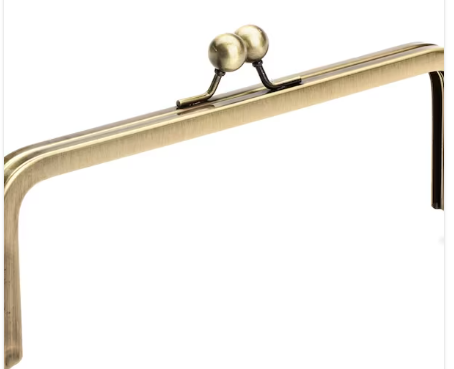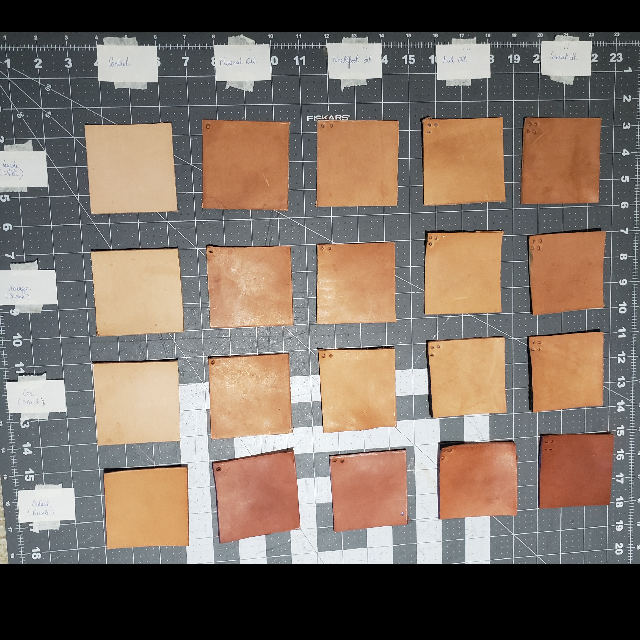-
Posts
1,282 -
Joined
Content Type
Profiles
Forums
Events
Blogs
Gallery
Everything posted by SUP
-
I've no idea really. I just saw it at an estate sale after someone had bought it. Just a perfunctory look where I held and examined it for a couple of moments, but it looked nice. The leather was soft. I have no idea if it was initially soft or got soft over the years. However, it was one of those kiss-locks and don't those require softer material? I looked online on e-bay and they have plenty of similar ones, some smooth, some not. They all look soft as well.
-
I saw a really old leather bag and it is beautifully tooled. The texture of that leather is like milled veg-tan - the wrinkly appearance rather than the smooth surface of regular veg-tan. I have been told that milled veg-tan does not hold tooling as well as non-milled. If so, what would make the tooling on that bag remain so long? Or is there a way to get that wrinkly appearance on regular veg-tan?
-
@bluekush Glad to be of help. Do put up pics once done.
-
Deep red or Mahogany with the roses antiqued in black. Or any such combination of dye and antiquing. I think that painting the roses could distract from the beauty of your tooling.
-
Great. Next time I am in a hurry, I will remember. I don't use very delicate leathers either. Although, I must confess I am a bit lazy to use the hair dryer even on my hair, leave alone on my leathers! I just let everything dry naturally. Just discovered this by accident when I kept the sheaths aside to dry, and thought I would put it up here. Hopefully, some hobbyists might benefit from it. And apparently, candle warmers are pretty popular and certainly inexpensive and easy to operate - a single switch! And temp controlled as well - H, M and L.
-
I just realized yesterday, when I inadvertently placed a couple of dyed -waiting-to-dry leather sheaths next to a candle warmer, that the heat from that candle warmer is sufficient to dry the leather. it is gentle enough to dry but not so hot that it will warp or damage the leather. It is essentially like a hot box that people make to dry their leathers, with bulbs. This uses a bulb as well. The ones with a warming base might not work but the ones with bulbs do. Only requirement -no fragrant candles, since leathers pick odors fast.
-

Pattern for handbag with kiss-clasp - where can I get one?
SUP replied to SUP's topic in Patterns and Templates
@rleather yes, it helps tremendously! Thank you so much. -
I have been looking for a pattern for a leather handbag with a kiss-clasp. Pic of the clasp blow. Not found it yet. If anyone knows where I can get such a pattern, I would appreciate the information. The only patterns I find are for cloth ones - not sure how the material translates when I want to make it of leather.
-
His patterns are great for learning different techniques.
-
Yes, that's probably true.
-
It is a nice pattern. Dieselpunk.ro has a different pattern for $1.99 each week. Have you seen them as well?
-

Beveling edges - I just keep getting worse at it, and it ruins my projects
SUP replied to Toffe's topic in Getting Started
I still have issues with beveling, @Toffe. However, once I remembered that beveling is actually just trimming the edges off the leather and that the beveler is a tiny knife, I now look at the blade on my tool and think of positioning that blade in the position to cut as I want, whether on a higher level, different angle or whatever is needed, including sharpening/stropping. Looking at it in a different way helps me get better results. It might make a difference for you too. -
I was offered it for 15 here. But I don't do sufficient tooling to warrant many swivel knives.
-
Thank you @DieselTech and @bruce johnson. I'm not a collector, so I'll probably pass.
-
I spelt the name wrong. Sorry. It is Divelbiss.
-
I might be able to lay my hands on a Devilbiss swivel knife. It seems to be in good condition. Are they good? Are they worth buying?
-
If I find my chisels difficult to pull out of the leather, I use a pan of wax as my punching board. I melt any old candles that I have around the house (no fragrance - that will transfer to the leather) in a baking pan. Once cool, it becomes a great punching board. Each time the wax surface become rough due to punching, it is a simple matter to put the pan back into the oven at low temperature to melt the wax and smoothen the surface again. This way, the chisel tips get waxed at each turn and slip out easily. If I find that the wax is transferring to the leather, I use an old piece of thinner split in between my leather and the wax. I anyway use thick splits as punching boards. Kinder on the chisels.
-
Report for 22nd March, 2024. The leather pieces showed some differences from 3 months ago. Firstly, an explanation of what the descriptions mean. Smoothness indicates the surface feel – silky smooth or rough. Shape indicates how the pieces hold their shape – whether the corners curl or the edges curve or even curve in a wavy manner. Stiffness indicates how easy it is to bend or fold the leather. Color: Indicates the extent of darkening. Smoothness: The leather pieces treated with Mineral oil were all the smoothest, having a silky feel. The next were the leather pieces treated with Neatsfoot oil and Coconut oil, which were similar - relatively silky. The Mink oil treated leather pieces felt a little rough, even more so than the control pieces. Color: Coconut oil darkened all the pieces the most, although all the pieces in all the locations except directly outside, are lighter now, than 3 months ago. in fact, they are almost as light as the leathers treated with the other oils. The least darkened are the leathers treated with Mink oil. Pieces treated with Mineral oil all have remarkably similar color except for the one outside. They also have remarkably uniform color - actually beautiful. Shape: The most warping was seen in the control leather pieces at every location. The Mink oil treated leathers were also relatively warped, the Coconut oil treated ones, less so. The leather pieces treated with Mineral oil were the least warped and held their flat shapes very well. Stiffness: Here, the stiffness differed more according to location. The leathers kept outside were the stiffest in their treatment categories. The least stiff were the ones treated with Coconut oil and then the ones with Neatsfoot oil. Most stiff were the leathers treated with Mineral oil. The leathers treated with Coconut oil are actually very soft. All the pieces treated with Coconut oil are the softest and smoothness is second only to Mineral oil treated leathers. This is surprising as, initially they had appeared a bit dry in Dec., 2023. They darkened earlier but over time, all except the leather placed outside are close in color to the leather pieces treated with the other oils. The leather pieces treated with Mineral oil are the flattest with least warping, the smoothest and all darkened uniformly and to the same extent in all locations except outside where the piece darkened significantly more, as expected. The darkening is also remarkably uniform over each piece. They are all however, also the stiffest.in their location categories. The leather pieces treated with Neatsfoot oil are moderate in every way. Moderately smooth, moderately stiff, moderately dark and moderately but not too warped. Mink oil continues to surprise me. The leather pieces in all locations feel least smooth, in fact a little rough. In all the locations- they feel like the controls – untreated. They are the most stiff and dry across all locations, including inside. They are however, the least darkened. Smell: they all smell like leather to me. There is no mold on any of the pieces. Seeing the results at this 6 month point (more or less), I can see why more than one ingredient is used to condition leather. Depending on the use of the leather goods, specific ingredients that complement each other can be selected to get the best results. This is still premature and I have added tallow, cod liver oil and lanolin to the line-up. I just added them a couple of days ago, so have not included them here. I will list them separately next week and from next time, list them all together, along with any other ingredient that I might add. If colors in the photograph appear different from my description, it could be the play of light.
-
@toxo. I will.
-
@jcuk thank you for that detailed explanation. Being still new to leatherwork (since end of Jan 2023) there is so much I don't know. It seems to me that the more I learn the more I realize I don't know! I will watch those videos. I will not have to hunt for the good ones, since you have provided them. I stitch towards myself too. After watching very many videos las year, I did learn enough to stitch away from me but it was a bit uncomfortable so I stopped. Now I can't wait to see those videos and learn the prick-and-awl method. (and all projects under way get set aside! All for family, so they won't complain.) See but my question still is this: With pricking chisels and then use of an awl, the hole is not punched first. The holes are just positioned with pricks, so that awl punch is the first time the leather gets perforated for each hole. Therefore, it will be a small hole. If a stitching awl is used on a hole already punched, will it not widen that hole? Unless of course, smaller holes are punched deliberately and the awl used is sized accordingly.? Did I just answer my own question?
-
@jcuk instead of first punching round holes and then using an awl individually on each hole to shape it, isn't it easier to case the stitches? Same result 0f angled stitches...isn't it? Unless I am missing something..
-
@Shazbaz In Australia you get great Kangaroo leather, isn't it?. That should be strong and thin enough for wallets. It's beautiful too. There are plenty of free leather wallets patterns on the net. That is one of the first things people make when starting leatherwork apparently. Have you checked the leather stores online and their free sections? You might find exactly what you want in one of them. I know Springfield leather had some free wallet patterns. Otherwise, such patterns go for a song on Etsy. Some people on Etsy also design based on your specifications - that is another option.
-
If you are using bought patterns, often, the distance between the stitching holes in the pattern do not exactly match any set of chisels like the one you have mentioned above. This discrepancy occurs because the method of measuring the distances between prongs varies. Many sellers, e.g. Dieselpunk.ro, use expensive chisel sets like Sinebrok chisels. For his patterns I use ordinary but also good chisels off Amazon, where the 6 and 9 prong chisels don't work but the 2 prong ones do. The same set works perfectly for patterns bought from other sellers off Etsy and I can use the 6 and 9 prong chisels there. So for the times when your chisel sets don't work for a pattern, you need single hole punches. Another reason would be because many pattern sellers tell you the size of the holes needed, e.g. 1mm or 1.5mm. because they expect you to use punches. Once you know the diameter of your chisel-punched holes of course, you can use chisels. Now about using the diamond stitching chisels, the patterns are often not made with those in mind, so the directions of the angles might differ in different parts of your product unless you map them all correctly. Much easier to punch round holes and case the stitches to get the required angles. Easier and faster, at least for me. Now, while it is true that punching holes actually takes off a bit of the leather while chisels only make a slit through the leather, most of the patterns have holes far enough apart not to much weaken the leather. For smaller items like wallets and watch straps I do not know since I don't make them. I think they will need finer holes and smaller stitches closer together than, say, a backpack or handbag or saddle.




